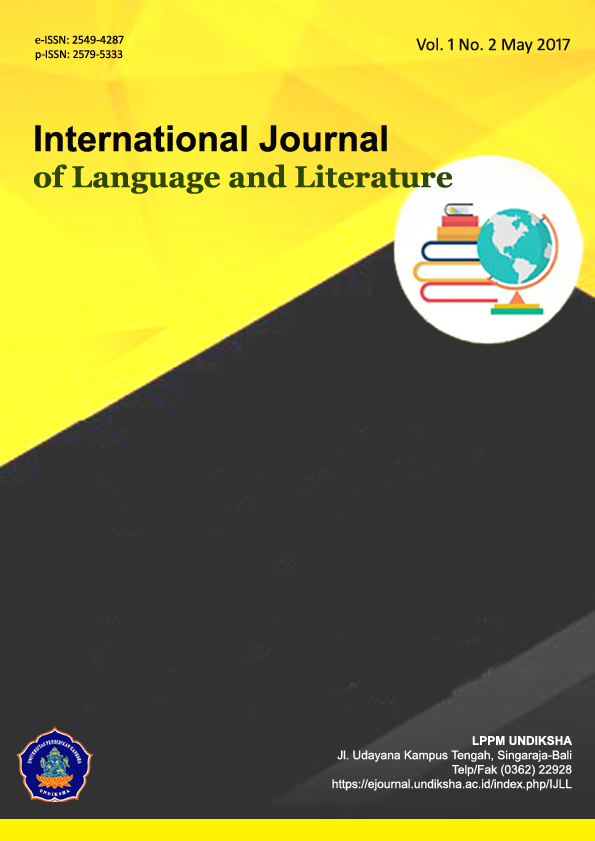‘HIDDEN OBJECT MEDIA’ FOR TEACHING ENGLISH AT THIRD GRADE ELEMENTARY STUDENTS IN SD LABORATORIUM UNDIKSHA SINGARAJA
DOI:
https://doi.org/10.23887/ijll.v1i2.12537Keywords:
hidden object media, handout, teaching English for young LearnersAbstract
This research aimed to (1) analyze the use of ‘Hidden Object Media’ in teaching English for third-grade elementary students in SD Lab Undiksha Singaraja. The subject of this research was thirty seven of third grade students in SD Lab Undiksha Singaraja at even semester academic year 2016/2017. This research categorized as descriptive qualitative in the form of graphs and percentage. Some instruments were used to conduct this research. There was interview guide, observation sheet and questionnaire. There are four media that was trying out based on topic of animals and body parts. Each media consist of teacher’s guidelines, brief story, hidden object handout, and list of possible post activities. Based on the result of students’ interview and teacher’s questionnaire it was found that hidden object media were able to involve students in learning, able to motivate and help students learn new vocabularies. The percentage shows that more than 78% in every session students felt happy, more than 57% in every session students felt helpful and 100% students feel motivated and feel that the media were good for them to be used. Thus, this media was proper to use for teaching English for third grade students.
References
Borkar, R. 2011. Interactive children’s books. Retrieved 9 March 2017 from http://www.buzzle.com/articles/interactive-childrens-books.html
Cameron, L. 2005. Teaching Languages to Young Learners. 8th edn. United Kingdom: Cambridge University Press.
Cameron, L., & McKay, P. 2010. Bringing creative teaching into the young learner classroom. New York: Oxford University Press.
Ghent, L. 2017. Why Use Media to Enhance Teaching and Learning. Using Media to Enhance Teaching and Learning. Retrieved 9 March 2017, from http://serc.carleton.edu/sp/library/media/why.html
Goh, C. 2006. Metacognitive instruction in listening for young learners. ELT Journal, 60(3), 222-232. http://dx.doi.org/10.1093/elt/ccl002
Homan, A. 2015. Using hidden object games to support language learning - Innovation: Education. Innovation: Education. Retrieved 24 March 2017, from http://tiie.w3.uvm.edu/blog/using- hidden-object-games-to-support-language-learning/#.WNRlPGh3tQQ
Mikits, J. 2009. The Use of Classroom Handouts. United States Military Academy. Retrieved 30 August 2017, from http://www.usma.edu/cfe/Literature/Mikits_09.pdf.
Nan-Zhao, Z, .2005. Four ‘Pillars of Learning for the Reorientation and Reorganisation of Curriculum: Reflections and Discussions, International Bureau of Education, UNESCO
Saorn, T. 2017. Interactive Book | 23 Studio |. 23-studio.com. Retrieved 23 March 2017, from http://www.23-studio.com/web/?page_id=21
Sevik, M. 2012. Teaching Listening Skills to Young Learners through “Listen and Do” Songs. English Teaching Forum, 3.
Downloads
Published
How to Cite
Issue
Section
License
IJLL Journal provides immediate open access to its content on the principle that making research freely available to the public to supports a greater global exchange of knowledge.

This work is licensed under a Creative Commons Attribution-ShareAlike 4.0 International License








